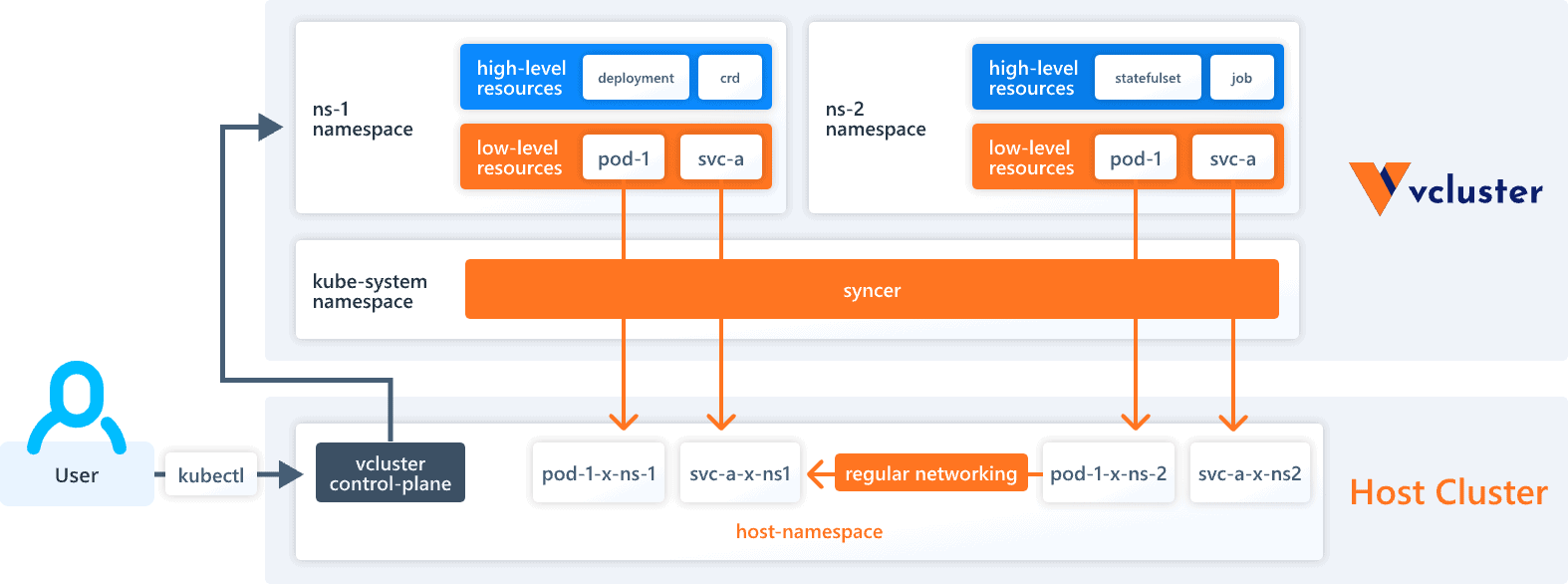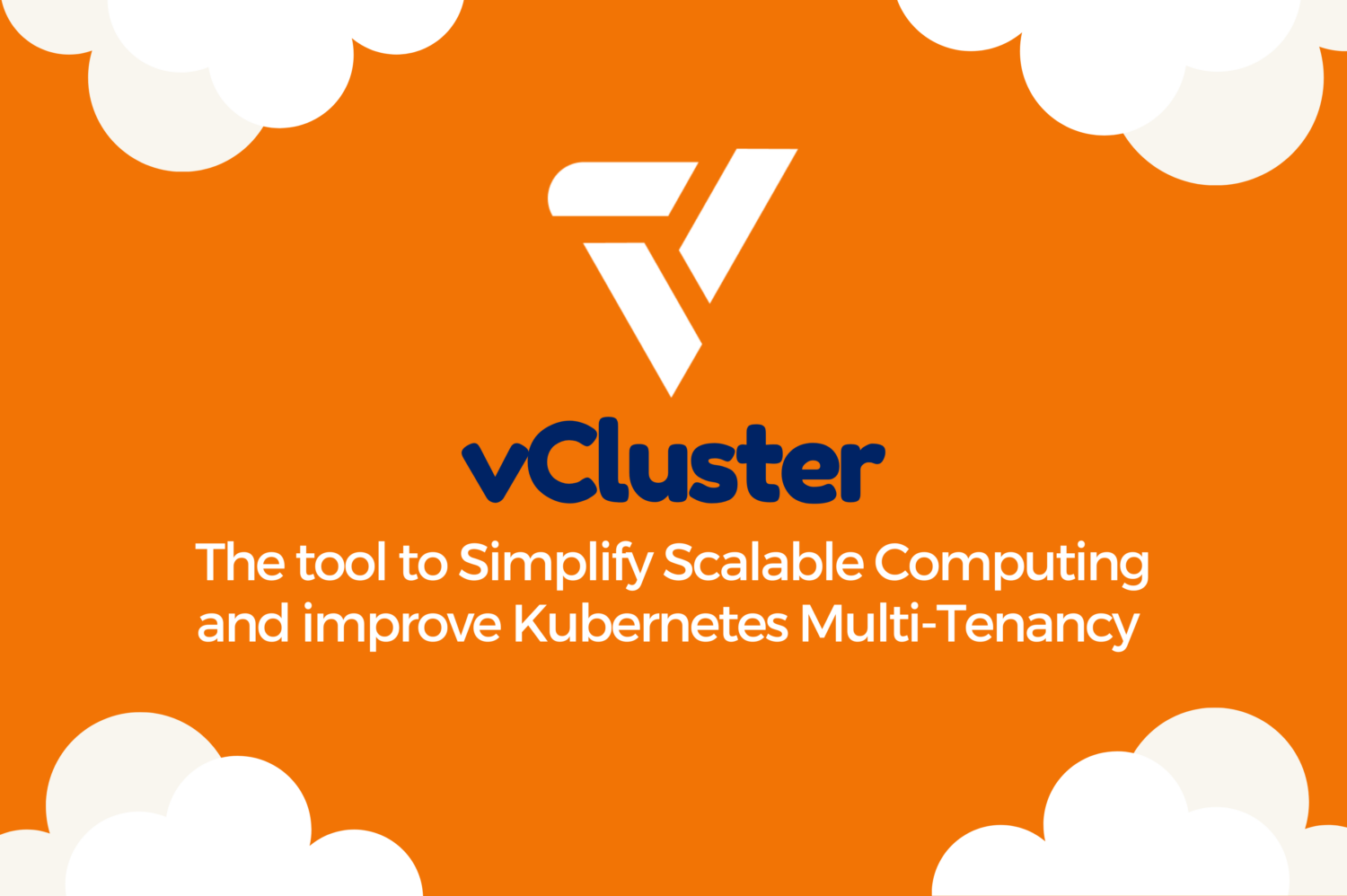Scalable Computing and Kubernetes Multi-Tenancy with vCluster
In today’s digital landscapes, businesses and organizations are constantly seeking ways to optimize their computing infrastructure to meet the ever-increasing demands of data processing and storage. This pursuit has given rise to virtual clusters, which offer a powerful solution for scaling computational resources horizontally in a flexible and efficient manner.
Furthermore, organizations are looking for innovative solutions that simplify the management of these virtual clusters as the demand for scalable and flexible computing resources continues to rise.
In this article, we will dive into the world of Kubernetes vCluster, a cutting-edge technology that offers a comprehensive platform for creating and managing virtual k8s clusters effortlessly. We will explore its features, advantages, real-life applications, and the potential it holds for transforming the way businesses deploy and utilize tens if not hundreds of virtual clusters.
But what is What is a virtual cluster?
A virtual cluster is a collection of virtual machines (VMs) or containers that are logically grouped together to function as a single, unified entity. Essentially, a virtual cluster allows organizations to harness the combined power of multiple computing resources, treating them as a cohesive unit. This pseudo-virtualization technology enables efficient resource allocation, resource isolation along with simplified management of complex computing tasks.
This brings us to one of the main applications of virtual clusters – in Multi-Tenancy. As we learned in our last article about Kubernetes Multi-Tenancy, the two main models to share Kubernetes clusters with multiple tenants, namely Namespace-based multitenancy and Cluster-based multi-tenancy, present several challenges such as lack of support for CRDs or partial RBAC support. Virtual clusters are a good alternative that help to overcome those challenges.
What is vCluster?
vCluster is an open-source, certified Kubernetes distribution. It is a powerful and user-friendly tool designed to simplify the creation and management of virtual Kubernetes clusters. vCluster allows you to create fully functional virtual Kubernetes clusters where each vCluster runs inside a namespace of the underlying k8s cluster. It offers better multi-tenancy and isolation than regular namespaces and is also a lot cheaper than creating separate clusters.
vCluster acts as a layer of abstraction that allows developers, engineers, and system administrators to effortlessly deploy, scale, and manage their virtual clusters across various cloud providers and Kubernetes environments.
It allows you to automate complex tasks and provides a centralized interface, which will help you save valuable time and effort. vCluster streamlines the process of setting up and maintaining virtual clusters allowing to operate hundreds of clusters for different teams and purposes.
Key Features and Functionality
vCluster works by abstracting the complexities of virtual cluster management and providing a platform for creating, scaling, and managing virtual clusters. Here are some of its main features:
Seamless Cluster Provisioning: vCluster eliminates the complexities of manually setting up virtual clusters by providing a simple and intuitive interface. With just a few clicks, users can effortlessly provision virtual clusters, defining the desired resources, such as CPU, memory, and storage, based on their requirements.
Multi-Tenancy and Isolation: vCluster enables multi-tenancy within virtual clusters, allowing different teams or projects to operate within their isolated environments. This ensures enhanced security and resource allocation, enabling efficient collaboration and seamless integration across various workspaces.
Automatic Resource Management: vCluster optimizes resource utilization by dynamically allocating computing resources based on workload demands. It intelligently scales the virtual cluster up or down, ensuring efficient resource allocation and minimizing costs.
High Availability and Fault Tolerance: vCluster incorporates “kubernetes on kubernetes” approach with its self-healing mechanisms to ensure high availability and fault tolerance. It automatically redistributes workloads across available resources in case of failures, minimizing downtime.
Architecture

Vclusters usually run as a single pod (scheduled by a StatefulSet) that consists of 2 containers, namely the control plane and the syncer.
vCluster Control plane:
Each vcluster has its own control plane consisting of:
- Kubernetes API server (point your kubectl requests to this vcluster API server)
- Data store (where the API stores all resources, real clusters run with etcd)
- Controller Manager (creates pods objects in the data store according to replica number in ReplicaSets etc.)
- (Optional) Scheduler (schedules workloads inside the virtual cluster. See scheduling for more info)
Syncer:
- A vcluster virtual because it does not have actual worker nodes or network but a syncer
- The syncer copies the pods that are created within the vcluster to the underlying host cluster
- Then, the host cluster will actually schedule the pod and the vcluster will keep the vcluster pod and host cluster pod in sync.
Host Cluster & Namespace:
- Vclusters run on top of another Kubernetes cluster (host cluster)
- Each vcluster runs as a regular StatefulSet inside a namespace (host namespace) of the host cluster
- Everything that created inside the vcluster lives either inside the vcluster itself or inside the host namespace.
- You can run multiple vclusters inside the same namespace and you can run vclusters inside another vcluster (vcluster nesting) too
Applications
Development and Testing Environments: vCluster simplifies the creation and management of development and testing environments. Developers can easily spin up isolated clusters for testing new features, running integration tests, or experimenting with different configurations, all while maintaining resource and cost-effectiveness.
Continuous Integration and Deployment (CI/CD): vCluster integrates with CI/CD pipelines, providing a scalable and consistent environment for building, testing, and deploying applications. By automating the provisioning and management of virtual clusters, vCluster enables faster and more efficient CI/CD processes, accelerating software development cycles.
Data Analytics and Machine Learning: Organizations dealing with data-intensive tasks, such as data analytics and machine learning, can leverage vCluster to efficiently process large datasets. With its ability to scale resources on-demand and distribute workloads across virtual clusters, vCluster enables faster and more cost-effective data processing, leading to valuable insights and improved decision-making. and ensuring uninterrupted operations.
Advantages of vCluster:
Simplified Management: vCluster abstracts the complexities of virtual cluster management, providing a user-friendly interface that simplifies deployment and maintenance tasks. This empowers teams to focus on their core objectives without the need for extensive expertise in cluster management.
Resource Efficiency: vCluster optimizes resource utilization by automatically adjusting cluster sizes based on workload demands. This leads to cost savings by ensuring efficient allocation of computing resources, eliminating the need for over-provisioning.
Scalability and Flexibility: vCluster enables seamless scalability, allowing businesses to effortlessly add or remove resources based on their evolving needs. This flexibility ensures that virtual clusters can adapt to fluctuating workloads without disruptions.
Conclusion
vCluster stands at the forefront of virtual cluster management, offering organizations a powerful solution for streamlining the creation, scaling, and management of virtual clusters. By abstracting the complexities of cluster management and providing a user-friendly interface, vCluster simplifies the process of deploying and maintaining virtual K8s clusters, saving time and effort for teams and administrators.
With vCluster, businesses can implement multi-tenancy, ensuring secure isolation and efficient resource allocation for different teams or projects within virtual clusters.
Do you need guidance with Kubernetes and Day-2 operations? Do not hesitate to contact us, we’re happy to help.

